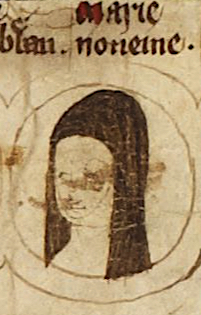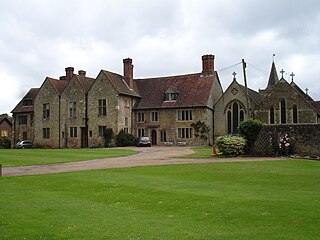A complicated role
Running a monastery in medieval England brought administrative and economic responsibilities that were joined to spiritual duties. As a woman, Sybil would not be summoned to Parliament as many of the male monastic superiors were. [9] However, as prioress she was under the authority of at least four powerful figures: the pope, the king, the diocesan bishop and the abbess of Fontevraud. The latter, though resident on the Continent, had an agent resident in England, termed a procurator or proctor general, who at times travelled extensively across the country attending to the affairs of the Order. [10]
Moreover, in theory the houses of the Order of Fontevraud were unlike many monastic communities in so far as in principle they had side by side a female house and a male house, all under the authority of the local prioress. The historical records regarding Amesbury Priory speak in the 14th century of a male house of 12 priests referred to as 'canons' (i.e. canons regular). As to the female house, we learn that in 1317–1318, it contained no less than 117 nuns (perhaps including small numbers of lay sisters), though 36 new nuns were consecrated in 1327. These numbers were much reduced in 1381, with only 28 nuns, besides the prioress. [11] At the time of the Dissolution of the monasteries and the Priory's closure in 1539, there seem only to have been the prioress and 33 nuns. [12]
Storms
As the 14th century closed, Dame Sybil became embroiled in some notable events. Firstly, in May 1398, some seven years after her election as prioress, an inquiry was ordered by the King into the government of the priory with a view to reforming it according to the ordinances and constitutions. Among other indications of indiscipline was the birth of a child in 1398 to a nun of Amesbury, Margaret Greenfield. [13] Before January 1399, Dame Sybil showed a decisive temperament by having the elderly Prior Robert Daubeneye thrown out of the monastery. In the uproar of accusations and counter-accusations that followed, she emerges as high-handed and the mixed royal and ecclesiastical enquiries were favourable to the Prior and his reputation as a priest in good standing, though he was not reinstated but was ordered to receive a pension.
However, on 14 March 1400 there was a sequel when ruffians invaded the monastery after nightfall and Sybil and some of the nuns were imprisoned for at least two days, the prioress was manhandled and perhaps the monastery's treasure was carried off. Upon her prompt complaint, Henry IV, crowned king on 13 October 1399, issued orders to officers of the crown to free the nuns and restore order, since "evildoers of the town have taken and imprisoned" them. [14]
The official investigations brought to light an attempt of Dame Sybil to pare down the number of canons from twelve to four, replacing them with secular priests. [15] This was a delicate moment since in 1388 Richard II, to whom Sybil's male relatives were steadfastly loyal, had been deposed by Henry IV. Her brother John had been heavily caught up in resistance to the new king, was imprisoned by a mob at Cirencester, and without trial beheaded on 7 January 1400, three months before the irruption at Amesbury.
There were difficulties for the so-called alien priories, that is, those monastic houses, usually small, that were dependencies of foreign, usually French, mother houses. [16] Communication with the mother house was often impossible and impolitic, and as a result, discipline at the English dependencies suffered. In 1378, all the monks in alien priories had been expelled from England and finally in 1414, under Henry V, those that remained were suppressed.
The situation at Amesbury was not so drastic, partly because the house fell into a distinct subcategory of its kind since for a long time the head of the house, the prioress, had been elected by the nuns, by the king's leave and with his confirmation, rather than being appointed by the abbess of Fontevraud, their nominal monastic superior. It would seem, however, that Amesbury suffered the same systemic disciplinary problems as elsewhere.
Over a decade after the earlier storm, the prioress launched an appeal to the King, claiming she had been evicted from the house and was afraid to enter it again. On 7 February 1415, Henry V, in the presence of Henry Chichele, Archbishop of Canterbury, ordered that she receive "suitable sustenance for herself and her servants from the spiritual and temporal possessions belonging to the said priory of Amesbury" until a visitation of the house could be conducted by the Archbishop and the ills remedied. [17] Again, Sybil kept her position as prioress.

The Royal Abbey of Our Lady of Fontevraud or Fontevrault was a monastery in the village of Fontevraud-l'Abbaye, near Chinon, in the former French duchy of Anjou. It was founded in 1101 by the itinerant preacher Robert of Arbrissel. The foundation flourished and became the center of a new monastic Order, the Order of Fontevraud. This order was composed of double monasteries, in which the community consisted of both men and women — in separate quarters of the abbey — all of whom were subject to the authority of the Abbess of Fontevraud. The Abbey of Fontevraud itself consisted of four separate communities, all managed by the same abbess.

Amesbury is a town and civil parish in Wiltshire, England. It is known for the prehistoric monument of Stonehenge which is within the parish. The town is claimed to be the oldest occupied settlement in Great Britain, having been first settled around 8820 BC. The parish includes the hamlets of Ratfyn and West Amesbury, and part of Boscombe Down military airfield.

Barford St Martin is a village and civil parish in Wiltshire, England, about 2.5 miles (4 km) west of Wilton, around the junction of the A30 and the B3089. Barford is known as one of the Nadder Valley villages, named for the River Nadder which flows through the parish.
Amesbury Abbey was a Benedictine abbey of women at Amesbury in Wiltshire, England, founded by Queen Ælfthryth in about the year 979 on what may have been the site of an earlier monastery. The abbey was dissolved in 1177 by Henry II, who founded in its place a house of the Order of Fontevraud, known as Amesbury Priory.
Amesbury Priory was a Benedictine monastery at Amesbury in Wiltshire, England, belonging to the Order of Fontevraud. It was founded in 1177 to replace the earlier Amesbury Abbey, a Saxon foundation established about the year 979. The Anglo-Norman Amesbury Priory was disbanded at the Dissolution of the monasteries and ceased to exist as a monastic house in 1539.
Westwood Priory was a priory of Benedictine nuns founded in 1153, near Droitwich, Worcestershire, England. It was a daughter house of Fontevraud Abbey, seized by the English crown in 1537 during the Dissolution of the monasteries.

Bradenstoke Priory was a medieval priory of Augustinian canons regular in the village of Bradenstoke, Wiltshire, England. Its site, in the north of the county about 1+1⁄2 miles (2.4 km) west of Lyneham, is on a ridge above the south side of Dauntsey Vale. In the 1930s the property was purchased by William Randolph Hearst and some of its structures were used by him for the renovation of St Donat's Castle near Llantwit Major, Wales.

Mary of Woodstock was the seventh named daughter of Edward I of England and Eleanor of Castile. She was a nun at Amesbury Priory, but lived very comfortably thanks to a generous allowance from her parents. Despite a papal travel prohibition in 1303, she travelled widely around the country.
Grovebury Priory, also known as La Grave or Grava was a priory in Leighton Buzzard, Bedfordshire, England. It was established in 1164 and disestablished in 1414.

Holywell Priory or Haliwell, Halliwell, or Halywell, was a religious house in Shoreditch, formerly in the historical county of Middlesex and now in the London Borough of Hackney. Its formal name was the Priory of St John the Baptist.
Campsey Priory,, was a religious house of Augustinian canonesses at Campsea Ashe, Suffolk, about 1.5 miles (2.5 km) south east of Wickham Market. It was founded shortly before 1195 on behalf of two of his sisters by Theobald de Valoines, who, with his wife Avice, had previously founded Hickling Priory in Norfolk for male canons in 1185. Both houses were suppressed in 1536.

Easebourne Priory was a priory in Easebourne, West Sussex, England.
Rusper Priory was a priory of Benedictine nuns in West Sussex, England.

Black Ladies Priory was a house of Benedictine nuns, located about 4 km west of Brewood in Staffordshire, on the northern edge of the hamlet of Kiddemore Green. Founded in the mid-12th century, it was a small, often struggling, house. It was dissolved in 1538, and a large house was built on the site in Tudor and Jacobean styles by the Giffard family of Chillington Hall. Much of this is incorporated in the present Black Ladies, a large, Grade II*-listed, private residence.

The Church of St Mary and St Melor is the parish church of the town of Amesbury, Wiltshire. The Grade I listed church dates from the 12th century and may be connected with the 10th-century Amesbury Priory or its 12th-century successor, Amesbury Abbey.

Lacock Abbey was a monastery founded at Lacock, in the county of Wiltshire in England, in the early 13th century by Ela, Countess of Salisbury, as a house of Augustinian Canonesses regular. It was seized by the crown in 1539 during the Dissolution of the Monasteries under Henry VIII. It then became a country house, Lacock Abbey, notable as the site of Henry Fox Talbot's early experiments in photography.

The Keldholme Priory election dispute occurred in Yorkshire, England, in 1308. After a series of resignations by its prioresses, the establishment was in a state of turmoil, and the Archbishop of York, William Greenfield, appointed one of the nuns to lead the house. His candidate, Emma de Ebor', was deemed unacceptable by many nuns, who undermined her from the start to the extent that she resigned three months later. The archbishop, forced to find another candidate, claimed that he was unable to do so from within the priory and appointed Joan de Pykering from nearby Rosedale Priory. It is likely that Keldholme saw de Pykering as an intruder, and it seems to have reacted against her in much the same way as to her predecessor.

The Littlemore Priory scandals took place between 1517 and 1518. They involved accusations of sexual immorality and sometimes brutal violence among the Benedictine nuns and their prioress at St Nicholas' Priory in Littlemore, in Oxfordshire, England. The priory was very small and poor, and had a history of troubled relations with its bishops, dating back to the mid-1400s. The scandal that came to light in 1517, however, became enough of a cause célèbre to contribute to the priory's eventual suppression in 1525. Katherine Wells, the prioress of Littlemore at that time, ran the priory with strict and often violent discipline. She was accused of regularly putting nuns in the stocks for extended periods, as well as physically assaulting them. She also had a baby by the priory's chaplain and had pawned the priory's jewels to pay for the child's upbringing. She entertained men in her parlour, even after the bishop had been made aware of the accusations, which involved heavy drinking. At least one other nun also had a child. On one occasion a number of the nuns broke out of the priory through a window and escaped into the surrounding villages for some weeks.

Amesbury Abbey is a Grade I listed mansion in Amesbury, Wiltshire, England, built in the 1830s for Sir Edmund Antrobus to designs of Thomas Hopper. The house, which stands in Grade II* listed parkland, is now used as a care home. It takes its name from Amesbury Abbey, founded in about 979 on or near the same site.













